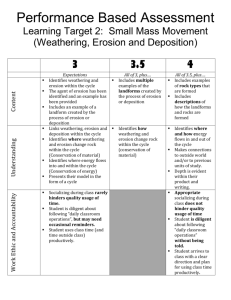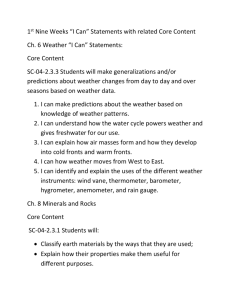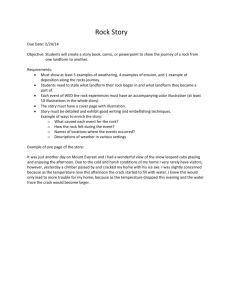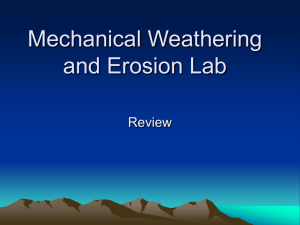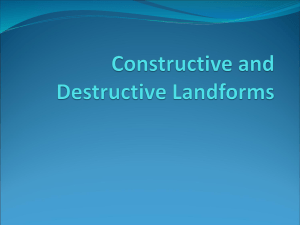Fourth Grade Science Standards 2015-2016
advertisement
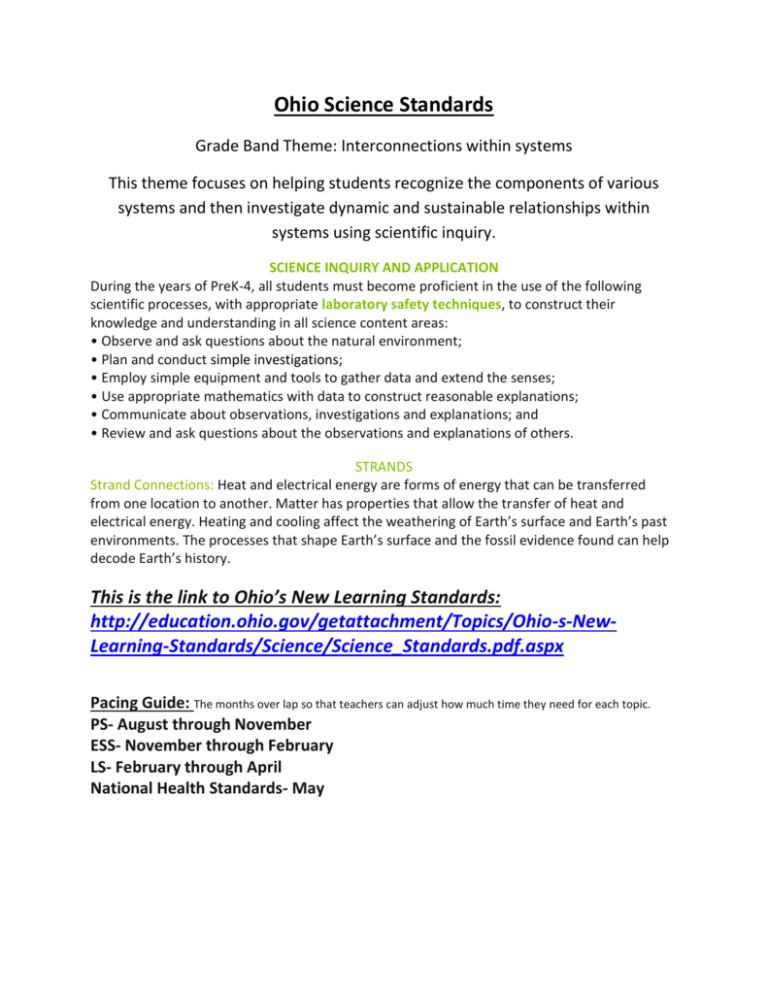
Ohio Science Standards Grade Band Theme: Interconnections within systems This theme focuses on helping students recognize the components of various systems and then investigate dynamic and sustainable relationships within systems using scientific inquiry. SCIENCE INQUIRY AND APPLICATION During the years of PreK-4, all students must become proficient in the use of the following scientific processes, with appropriate laboratory safety techniques, to construct their knowledge and understanding in all science content areas: • Observe and ask questions about the natural environment; • Plan and conduct simple investigations; • Employ simple equipment and tools to gather data and extend the senses; • Use appropriate mathematics with data to construct reasonable explanations; • Communicate about observations, investigations and explanations; and • Review and ask questions about the observations and explanations of others. STRANDS Strand Connections: Heat and electrical energy are forms of energy that can be transferred from one location to another. Matter has properties that allow the transfer of heat and electrical energy. Heating and cooling affect the weathering of Earth’s surface and Earth’s past environments. The processes that shape Earth’s surface and the fossil evidence found can help decode Earth’s history. This is the link to Ohio’s New Learning Standards: http://education.ohio.gov/getattachment/Topics/Ohio-s-NewLearning-Standards/Science/Science_Standards.pdf.aspx Pacing Guide: The months over lap so that teachers can adjust how much time they need for each topic. PS- August through November ESS- November through February LS- February through April National Health Standards- May Physical Science (PS) August-November Topic: Electricity, Heat and Matter This topic focuses on the conservation of matter and the processes of energy transfer and transformation, especially as they relate to heat and electrical energy. The total amount of matter is conserved when it undergoes a change. Energy can be transformed from one form to another or can be transferred from one location to another. Content Statement: The total amount of matter is conserved when it undergoes a change. When an object is broken into smaller pieces, when a solid is dissolved in a liquid or when matter changes state (solid, liquid gas), the total amount of matter remains constant. Concepts: 1.) Some properties of objects may stay the same even when other properties change. For example, water can change from a liquid to a solid, but the mass* of the water remains the same. Parts of an object or material may be assembled in different configurations, but the mass* remains the same. The sum of all of the parts in an object equals the mass* of the object. 2.) When a solid is dissolved in a liquid, the mass* of the mixture is equal to the sum of the masses* of the liquid and solid. At this grade level, the discussion of conservation of matter should be limited to a macroscopic, observable level. Conservation of matter must be developed from experimental evidence collected in the classroom. After the concept has been well established with experimental data and evidence, investigations can include interactions that are more complex where the mass* may not appear to stay constant (e.g., fizzing tablets in water). Note: Mass* is an additive property of objects and volume is usually an additive property for the same material at the same conditions. However, volume is not always an additive property, especially if different substances are involved. For example; mixing alcohol with water results in a volume that is significantly less than the sum of the volumes. *While mass is the scientifically correct term to use in this context, the NAEP 2009 Science Framework (page 27) recommends using the more familiar term “weight” in the elementary grades with the distinction between mass and weight being introduced at the middle school level. In Ohio, students will not be assessed on the differences between mass and weight until Grade 6. VISIONS INTO PRACTICE: CLASSROOM EXAMPLES This section provides examples of tasks that students may perform; this includes guidance for developing classroom performance tasks. It is not an all-inclusive checklist of what should be done, but is a springboard for generating innovative ideas DESIGNING TECHNOLOGICAL/ ENGINEERING SOLUTIONS USING SCIENCE CONCEPTS Evaluate research data providing information about the decomposition time for paper, glass, plastic and aluminum. Propose a sustainable plan that might be adopted by a larger population of citizens for minimizing waste products and reserving more space in our landfills. Develop presentation that could be for an outside audience with the authority to implement the plan within a community. DEMONSTRATING SCIENCE KNOWLEDGE INTERPRETING AND COMMUNICATING SCIENCE CONCEPTS RECALLING ACCURATE SCIENCE Investigate what happens to the total amount of mass* during many types of changes (e.g., ice melting, salt dissolving, paper tearing, candle burning, Alka-Seltzer in water). Propose reasons for any difference in the final weight (mass). Design a revised experiment to test proposals. Explain why the volume of water decreases when placed in an open container and left to sit for an extended period of time. Recognize that the amount of matter stays constant during any change. COMMON MISCONCEPTIONS • Gases are not matter because most are invisible. • Gases do not have mass*. • When things dissolve, they disappear. • Melting and dissolving are confused. • Mass* and volume, which both describe an amount of matter, are the same property. • Breaking something or dissolving makes it weigh less. • Changing the shape changes the mass* and volume. • Students believe matter is lost during burning. • Students believe that a warmed gas weighs less than the same gas that is cooler (Driver, Squires, Rushworth & Wood-Robinson, 1994). Physical Science (PS) August-November Topic: Electricity, Heat and Matter This topic focuses on the conservation of matter and the processes of energy transfer and transformation, especially as they relate to heat and electrical energy. The total amount of matter is conserved when it undergoes a change. Energy can be transformed from one form to another or can be transferred from one location to another. Content Statement: Energy can be transformed from one form to another or can be transferred from one location to another. Energy transfers from hot objects to cold objects as heat, resulting in a temperature change. Electric circuits require a complete loop of conducting materials through which an electrical energy can be transferred. Electrical energy in circuits can be transformed to other forms of energy, including light, heat, sound and motion. Electricity and magnetism are closely related. Concepts: 1.) The addition of heat may increase the temperature of an object. The removal of heat may decrease the temperature of an object. There are materials in which the entire object becomes hot when one part of the object is heated (e.g., in a metal pan, heat flows through the pan on the stove transferring the heat from the burner outside the pan to the food in the pan). There are other objects in which parts of the object remain cool even when another part of the object is heated (e.g., in a Styrofoam cup, very little of the warmth from hot liquid inside the cup is transferred to the hand holding the cup). 2.) Electrical conductors are materials through which electricity can flow easily. Electricity introduced to one part of the object spreads to other parts of the object (e.g., copper wire is an electrical conductor because electricity flows through the wires in a lamp from the outlet to the light bulb and back to the outlet). 3.) Electrical insulators are materials through which electricity cannot flow easily. Electricity introduced to one part of the object does not spread to other parts of the object (e.g., rubber surrounding a copper wire is an electrical insulator because electricity does not flow through the rubber to the hand holding it). 4.) Electrical conductivity must be explored through testing common materials to determine their conductive properties. In order for electricity to flow through a circuit, there must be a complete loop through which the electricity can pass. When an electrical device (e.g., lamp, buzzer, motor) is not part of a complete loop, the device will not work. Electric circuits must be introduced in the laboratory by testing different combinations of electrical components. When an electrical device is a part of a complete loop, the electrical energy can be changed into light, sound, heat or magnetic energy. Electrical devices in a working circuit often get warmer. 5.) When a magnet moves in relation to a coil of wire, electricity can flow through the coil. When a wire conducts electricity, the wire has magnetic properties and can push and/or pull magnets. The connections between electricity and magnetism must be explored in the laboratory through experimentation. VISIONS INTO PRACTICE: CLASSROOM EXAMPLES This section provides examples of tasks that students may perform; this includes guidance for developing classroom performance tasks. It is not an all-inclusive checklist of what should be done, but is a springboard for generating innovative ideas. Design a device involving energy transfers. DESIGNING TECHNOLOGICAL/ ENGINEERING SOLUTIONS USING SCIENCE CONCEPTS Design and construct a device that causes a small cart to roll and involves energy transfers between four objects (e.g., push a ball off a table so it falls on an object that releases rubber band cart). DESIGNING TECHNOLOGICAL/ ENGINEERING SOLUTIONS USING SCIENCE CONCEPTS Design and construct a switch that can turn a light on and off in a circuit. DEMONSTRATING SCIENCE KNOWLEDGE INTERPRETING AND COMMUNICATING SCIENCE CONCEPTS RECALLING ACCURATE SCIENCE Design and construct a device that causes a small cart to roll and involves energy transfers between four objects (e.g., push a ball off a table so it falls on an object that releases a rubber band cart). Investigate a simple circuit. DEMONSTRATING INTERPRETING AND SCIENCE COMMUNICATING KNOWLEDGE SCIENCE CONCEPTS Recognize that energy can cause motion or create change. Build a circuit that contains two light bulbs. Analyze the differences between working and nonworking circuits and determine patterns and trends in the experimental evidence. Formulate a conceptual model of a working circuit based upon the trends in the experimental evidence. Recognize that a working circuit requires a continuous loop of electrical conductors. Pictorially represent ways to assemble the circuit and note which are able to light the bulbs and which are not. Compare and contrast circuits that light the bulbs with circuits that do not light the bulbs. Outline the functions of the components of a simple electric circuit (conductor, insulator, energy source, light bulb, switch). Pictorially represent the flow of energy in a circuit in which a battery is used to light a bulb. RECALLING ACCURATE SCIENCE DESIGNING TECHNOLOGICAL/ ENGINEERING SOLUTIONS USING SCIENCE CONCEPTS Investigate the transfer of heat energy. DEMONSTRATING INTERPRETING AND SCIENCE COMMUNICATING KNOWLEDGE SCIENCE CONCEPTS Plan and implement an experiment to investigate the energy transfer between hot (but not hot enough to burn) and cold water. Formulate a conceptual model that can account for the trends observed in the results. Organize and represent the data for easy interpretation. Analyze the data to determine patterns and trends. Explain the trends in the results using the conceptual model. RECALLING ACCURATE SCIENCE Measure the temperature of water. Recognize that an increase in temperature indicates an increase in heat energy and a decrease in temperature indicates a decrease in heat energy. COMMON MISCONCEPTIONS • Some items cannot be heated. • Metals get hot easily because they “draw in heat.” • Energy is a thing, an object or something that is tangible. • Cold can be transferred. • Larger magnets are stronger than smaller magnets. • Current flows from a battery (or other source of electricity) to a light bulb (or other item that consumes electricity), but not from the light bulb to the battery. • Electricity is produced in the wall socket. • Pure water is a good conductor of electricity. • Electricity from a dry cell will shock or hurt if it is touched. • All wires are insulated. • Birds can perch on bare wires without being hurt because birds have insulated feet. • A charge object can only affect other charged objects. • Ice cannot change temperature. • Heat is a substance. • Heat is not energy. • Temperature is a property of a particular material or object (metal is naturally colder than plastic). • The temperature of an object depends on its size. • Heat and cold are different, rather than being opposite ends of a continuum. • Objects of different temperatures that are in constant contact with each other or in contact with air at a different temperature do not necessarily move toward the same temperature. • Heat only travels upward. • Heat rises. • Objects that readily become warm (conductors of heat) do not readily become cold. Earth and Space Science (ESS) November-February Topic: Earth’s Surface This topic focuses on the variety of processes that shape and reshape Earth’s surface. Earth’s surface has specific characteristics and landforms that can be identified. The surface of Earth changes due to weathering. The surface of Earth changes due to erosion and deposition. Content Statement: Earth’s surface has specific characteristics and landforms that can be identified. About 70 percent of the Earth’s surface is covered with water and most of that is the ocean. Only a small portion of the Earth’s water is freshwater, which is found in rivers, lakes and ground water. Earth’s surface can change due to erosion and deposition of soil, rock or sediment. Catastrophic events such as flooding, volcanoes and earthquakes can create landforms. 1.) Earth is known as the Blue Planet because about 70 percent of Earth’s surface is covered in water. Freshwater is a small percentage of the overall water found on Earth; the majority is oceanic. 2.) There are many different processes that continually build up or tear down the surface of Earth. These processes include erosion, deposition, volcanic activity, earthquakes, glacial movement and weathering. 3.) Beginning to recognize common landforms or features through field investigations, field trips, topographic maps, remote sensing data, aerial photographs, physical geography maps and/or photographs (through books or virtually) are important ways to understand the formation of landforms and features. Common landforms and features include streams, deltas, floodplains, hills, mountains/mountain ranges, valleys, sinkholes, caves, canyons, glacial features, dunes, springs, volcanoes and islands. 4.) Connecting the processes that must occur to the resulting landform, feature or characteristic should be emphasized. This can be demonstrated through experiments, investigations (including virtual experiences) or field observations. Technology can help illustrate specific features that are not found locally or demonstrate change that occurred (e.g., using satellite photos of an erosion event such as flooding). VISIONS INTO PRACTICE: CLASSROOM EXAMPLES This section provides examples of tasks that students may perform; this includes guidance for developing classroom performance tasks. It is not an all-inclusive checklist of what should be done, but is a springboard for generating innovative ideas. DESIGNING DEMONSTRATING INTERPRETING AND RECALLING TECHNOLOGICAL/ SCIENCE COMMUNICATING ACCURATE SCIENCE ENGINEERING KNOWLEDGE SCIENCE SOLUTIONS CONCEPTS USING SCIENCE CONCEPTS Research a specific weathering feature (such as a sinkhole or cave). Evaluate the risk of collapse and methods of prevention of collapse (using actual data) and recommend one solution based on the scientific data. Create a model (virtual, graphic or 3-D) of the actual cave or sinkhole and demonstrate the risk of collapse and how the suggested preventative measure or solution impacts that risk. Plan, build and use a model (such as a small-scale stream table) that can demonstrate the formation of a landform or feature that formed through contact with water (alluvial fan, sinkhole, mid channel bar, canyon, valley, depositional islands). Ask: What factors accelerate the processes? What factors must exist for the landform to form? Share findings with the class Using topographic or aerial maps, locate areas that have been formed through deposition and erosion. Include areas of Ohio that have been impacted by glacial ice or movement. Discuss findings with the class. Recognize that 70 percent of Earth’s surface is water, which is why Earth is known as the Blue Planet. Identify common landforms from maps or graphics. COMMON MISCONCEPTIONS • NSTA offers a list of landform resources at http://learningcenter.nsta.org/search.aspx?action=quicksearch&text=landforms. Included are guides for formative assessment techniques that can be used to determine student misconceptions about landform formation, weathering and erosion. One reference in particular (an assessment probe) can be found at http://learningcenter.nsta.org/product_detail.aspx?id=10.2505/9780873552554.22. It deals with beach sand and applies to all Earth Science content at grade 4. • Funded by the National Science Foundation, Beyond Penguins and Polar Bears is an online magazine for K-5 teachers. For a list of common misconceptions about glacial movement, weathering and erosion, as well as ways to address them, visit http://beyondpenguins.nsdl.org/issue/column.php?date=August2009&departmentid=professional&c olumnid=professional!misconceptions. Earth and Space Science (ESS) November-February Topic: Earth’s Surface This topic focuses on the variety of processes that shape and reshape Earth’s surface. Earth’s surface has specific characteristics and landforms that can be identified. The surface of Earth changes due to weathering. The surface of Earth changes due to erosion and deposition. Content Statement: The surface of Earth changes due to weathering. Rocks change shape, size and/or form due to water or ice movement, freeze and thaw, wind, plant growth, gases in the air, pollution and catastrophic events such as earthquakes, mass wasting, flooding and volcanic activity. (Note: the ice movement refers to large bodies of ice, such as glaciers that can break large rocks into small ones) Concepts: 1.) Different types of rock weather at different rates due to specific characteristics of the rock and the exposure to weathering factors (e.g., freezing/thawing, wind, water). Weathering is defined as a group of processes that change rock at or near Earth’s surface. Some weathering processes take a long time to occur, while some weathering processes occur quickly. 2.) The weathering process must be observed in nature, through classroom experimentation or virtually. Seeing tree roots fracturing bedrock or the effect of years of precipitation on a marble statue can illustrate ways that rocks change shape over time. Investigations can include classroom simulations, laboratory testing and field observations. VISIONS INTO PRACTICE: CLASSROOM EXAMPLES This section provides examples of tasks that students may perform; this includes guidance for developing classroom performance tasks. It is not an all-inclusive checklist of what should be done, but is a springboard for generating innovative ideas DESIGNING DEMONSTRATING SCIENCE INTERPRETING AND RECALLING TECHNOLOGICAL/ KNOWLEDGE COMMUNICATING SCIENCE ACCURATE ENGINEERING SOLUTIONS CONCEPTS SCIENCE USING SCIENCE CONCEPTS Research a specific weathering feature (e.g., sinkhole, cave). Evaluate the risk of collapse and methods of prevention of collapse (using actual data) and recommend one solution based on the scientific data. Create a model (virtual, graphic or 3-D) of the actual cave or sinkhole and demonstrate the risk of collapse and how the suggested preventative measure or solution impacts that risk Plan and implement an experiment to model and compare different types of weathering and/or rates of weathering that can occur. Differentiate between weathering and erosion. Using geologic, topographic or aerial maps, research areas in the U.S. that are impacted by natural sinkholes, caverns or caves. Collect data regarding the characteristics of these regions. Compare and contrast the data to determine common characteristics that are present in each area. Represent findings graphically. Identify weathering as processes that change rock at or near Earth’s surface. Recognize that weathering can occur at different rates. Recognize that water, wind, pollution/gases in the air, ice movement, earthquakes, volcanoes, freezing/thawing and plant action can all weather rock and soil. COMMON MISCONCEPTIONS • Funded by the National Science Foundation, Beyond Penguins and Polar Bears is an online magazine for K-5 teachers. For a list of common misconceptions about glacial movement, weathering and erosion, as well as ways to address them, visit http://beyondpenguins.nsdl.org/issue/column.php?date=August2009&departmentid=professional&columnid=professional!misconceptions Earth and Space Science (ESS) November-February Topic: Earth’s Surface This topic focuses on the variety of processes that shape and reshape Earth’s surface. Earth’s surface has specific characteristics and landforms that can be identified. The surface of Earth changes due to weathering. The surface of Earth changes due to erosion and deposition. Content Statement: The surface of Earth changes due to erosion and deposition. Water, wind and ice physically remove and carry (erosion) rock, soil and sediment and deposit the material in a new location. Gravitational force affects movements of water, rock and soil. Concepts: 1.) Erosion is a process that transports rock, soil or sediment to a different location. Weathering is the breakdown of large rock into smaller pieces of rock. Erosion is what carries the weathered material to a new location. Gravity plays an important role in understanding erosion, especially catastrophic events like mass wasting (e.g., mudslides, avalanches, landslides) or flooding. 2.) Erosion is a “destructive” process and deposition is a “constructive” process. Erosion and deposition directly contribute to landforms and features formation that are included in grade 4. Topographic maps and aerial photographs can be used to locate erosional and depositional areas in Ohio. Surficial geology maps also can illustrate the patterns of glacial erosion and deposition that have occurred. Field trips and field investigations (may be virtual) are recommended as erosional and depositional features that can be seen locally or within the state can help to connect the concept of erosion and deposition to the real world. VISIONS INTO PRACTICE: CLASSROOM EXAMPLES This section provides examples of tasks that students may perform; this includes guidance for developing classroom performance tasks. It is not an all-inclusive checklist of what should be done, but is a springboard for generating innovative ideas DESIGNING DEMONSTRATING SCIENCE INTERPRETING AND RECALLING TECHNOLOGICAL/ KNOWLEDGE COMMUNICATING SCIENCE ACCURATE ENGINEERING SOLUTIONS CONCEPTS SCIENCE USING SCIENCE CONCEPTS Sediment fences are often placed around construction sites to help control sediment from moving offsite (erosion) into the surrounding environment (deposition). Design and construct a model of one specific sediment-control measure (using scientific research). Evaluate and test it using different types of materials. Different groups in the class should model different methods of control. Each group should present findings and demonstrate the models. Use actual geologic data from a specific location, such as the Grand Canyon. Research the formation of the canyon. Ask: Why does some rock weather and erode faster than others? What caused the weathering and erosion in the canyon? How can the age of the canyon be estimated? Use the research data to make a geologic cross section (3-D or virtual model or a graphic) to model the canyon. Differentiate between weathering and erosion. Compare and contrast erosion and deposition. Identify erosion as a process that transports rock, soil or sediment to a new location. Identify deposition as the settling or coming to rest of transported rock, soil or sediment. Life Science (LS) February-April Topic: Earth’s Living History This topic focuses on using fossil evidence and living organisms to observe that suitable habitats depend upon a combination of biotic and abiotic factors. Changes in an organism’s environment are sometimes beneficial to its survival and sometimes harmful. Fossils can be compared to one another and to present-day organisms according to their similarities and differences. Content Statement: Changes in an organism’s environment are sometimes beneficial to its survival and sometimes harmful. Ecosystems can change gradually or dramatically. When the environment changes, some plants and animals survive and reproduce and others die or move to new locations. An animal’s patterns of behavior are related to the environment. This includes the kinds and numbers of other organisms present, the availability of food and resources, and the physical attributes of the environment. Concepts: 1.) Ecosystems are based on interrelationships among and between biotic and abiotic factors. Ohio has experienced various weather patterns. Some parts of Ohio hosted glaciers and other parts of Ohio were submerged with water. Ecosystems can change rapidly (e.g., volcanoes, earthquakes, or fire) or very slowly (e.g., climate change). Major changes over a short period of time can have a significant impact on the ecosystem and the populations of plants and animals living there. The changes that occur in the plant and animal populations can impact access to resources for the remaining organisms, which may result in migration or death. The fossil record provides evidence for changes in populations of species. 2.) Researching and investigating specific areas in Ohio (e.g., Cedar Bog, Lake Erie, Hocking Hills, Caesar Creek, Kelly’s Island) via field studies, virtual field trips or other references must be used to explore the relationships between previous environments, changes that have occurred in the environments and the species that lived there. Note: Grade 4 ES focuses on changes to Earth’s surface due to erosion, deposition of soil, rock sediment, flooding, volcanoes and earthquakes that can be taught along with this content. VISIONS INTO PRACTICE: CLASSROOM EXAMPLES This section provides examples of tasks that students may perform; this includes guidance for developing classroom performance tasks. It is not an all-inclusive checklist of what should be done, but is a springboard for generating innovative ideas DESIGNING DEMONSTRATING SCIENCE INTERPRETING AND RECALLING TECHNOLOGICAL/ KNOWLEDGE COMMUNICATING SCIENCE ACCURATE ENGINEERING SOLUTIONS CONCEPTS SCIENCE USING SCIENCE CONCEPTS Critique plans (written or oral) from different organizations to reintroduce a species into an Ohio environment. Write a newspaper article in support or against the reintroduction of the species based upon scientific facts. Conduct an investigation to determine if removing or adding plants to an area increases or decreases erosion. Ask: How does this impact other organisms in that environment? Read a firsthand description, view drawings of Ohio ecosystems as first observed by explorers and compare the historical environmental descriptions to the current environment. Explain the changes that occurred in the biotic and abiotic components of the ecosystem. Describe the immediate consequences of rapid ecosystem change for organisms within an ecosystem and describe the consequences this change will have on an ecosystem a decade or more later (e.g., flooding, wind storms, snowfall, volcanic eruptions). Describe major changes in Ohio’s environments over time and the organisms supported in each (e.g., oceanic, glacial, wetlands, forests). COMMON MISCONCEPTIONS • Students may think that people provide the materials (water, nutrients, light) needed for plants to survive. Beyond Penguins and Polar Bears is an online magazine for K-5 teachers that provide information for misconceptions about plants. • A list of common ecological misconceptions about adaptation is provided with strategies for implementing the 5E model of instruction to overcome misconception Life Science (LS) February- April Topic: Earth’s Living History This topic focuses on using fossil evidence and living organisms to observe that suitable habitats depend upon a combination of biotic and abiotic factors. Changes in an organism’s environment are sometimes beneficial to its survival and sometimes harmful. Fossils can be compared to one another and to present-day organisms according to their similarities and differences. Content Statement: Fossils can be compared to one another and to present-day organisms according to their similarities and differences. The concept of biodiversity is expanded to include different classification schemes based upon shared internal and external characteristics of organisms. Most types of organisms that have lived on Earth no longer exist. Fossils provide a point of comparison between the types of organisms that lived long ago and those existing today. Concepts: 1.) Fossils provide evidence that many plant and animal species are extinct and that many species have changed over time. The types of fossils that are present provide evidence about the nature of the environment at that time. As the environment changed so did the types of organisms that could survive in that environment. 2.) The opportunity to learn about an increasing variety of living organisms, both the familiar and the exotic, should be provided. The observations and descriptions of organisms should become more precise in identifying similarities and differences based upon observed structures. Emphasis can still be on external features; however, finer detail than before should be included. Hand lenses and microscopes should be routinely used. Microscopes are used not to study cell structure but to begin exploring the world of organisms that cannot be seen by the unaided eye. Non-Linnaean classification systems should be developed that focus on gross anatomy, behavior patterns, habitats and other features. VISIONS INTO PRACTICE: CLASSROOM EXAMPLES This section provides examples of tasks that students may perform; this includes guidance for developing classroom performance tasks. It is not an all-inclusive checklist of what should be done, but is a springboard for generating innovative ideas DESIGNING TECHNOLOGICAL/ ENGINEERING SOLUTIONS USING SCIENCE CONCEPTS DEMONSTRATING SCIENCE KNOWLEDGE INTERPRETING AND COMMUNICATING SCIENCE CONCEPTS Propose and test multiple ways that living things with soft body parts can leave fossil evidence. Experiment with making fossils to determine some of the necessary (living and nonliving) conditions for making fossils and to determine if similar conditions exist today. Materials used should include clay, dough, sand, mud, etc. Conditions should include moist, wet and dry. Representations of living organisms used should include those with hard body parts (exoskeletons, bones) and those with soft body parts (plants). From observation of fossils in rock layers, infer the environmental conditions that existed when the fossils were formed (e.g., fish fossils would indicate a body of water existed at the time the fossils formed). For more information visit http://www.ohiohistorycentral. org/subcategory_topic. php?c=NH&s=GEOL&t=FOSS. RECALLING ACCURATE SCIENCE Identify evidence that can be used to determine the existence of an organism. For more information, visit http://www.ucmp.berkeley.edu/ education/explorations/tours/intro/ Introkto4b/tour1nav.php COMMON MISCONCEPTIONS • The Annenberg Media series Essential Science for Teachers: Life Science: Session 5: Children’s Ideas provides greater insight to misconceptions children hold about differing traits within a species and their causes. Strategies to address those misconceptions are addressed. • Students may have the naïve conception that if organisms look alike, then they must have a common evolutionary history. Health: Nutrition- April-May Describe the structure and function of the digestive system and behaviors that will protect it. Describe why the body needs food. Explain the role of nutrients and fiber in a healthful diet. Organize food according to the major nutrients they contain. Use My Plate to classify foods into the five basic food groups. Describe the importance of a balanced diet for overall health. Analyze food labels to make healthful choices for meals and snacks. Explain how the amount and food eaten influence health including body weight and stress levels. Identify ways to prepare and handle foods safely. Resources: McGraw Hill: chapter 5, National Dairy Council – Pyramid Exploration, - Food Smarts: My Pyramid for Kids [26:16] Nutrition Labels: Our Guides to Healthy Eating [18:00], choosemyplate.gov Human Body: Circulatory and Respiratory Systems- April-May Describe the structure and function of the circulatory system and behaviors that will protect it. Diagram and label the four chambers of the heart. Show the relationship between increasing breathing rate and heart rate during physical activity. Describe the structure and function of the respiratory system and behaviors that will protect it. Explain how the circulatory and respiratory systems work together. Resources: McGraw Hill : chapter 2, United Streaming, Skills for Success – Human Body by Carson Dellosa Water Safety Describe ways to which safe and healthy school and community environments can promote personal health. Describe ways to prevent common childhood injuries and health problems. Describe how the school and community can support personal health practices and behaviors. Identify safety rules to use in water. Practice health enhancing behaviors and reduce health risks. (YMCA) Resources: McGraw Hill pages 238 – 240

